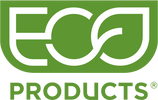LEARN
Circularity
A circular economy is a system without waste.
Circular economies mimic nature, as there is no “waste” in nature – at least not in the modern sense of the term.
Transitioning to a more circular economy is also an effective climate strategy, and everyone has a role to play.
At Eco-Products, we believe our role is:
- Producing foodservice products made with renewable resources that can be composted alongside food and yard waste to create compost – a valuable soil amendment and climate fighting tool.
- Producing foodservice products made with post-consumer recycled content, which helps support recycling systems by creating end-market demand for material that might otherwise be landfilled, and reduces the amount of traditional, petroleum-based plastic needed for these items.
- Advocating for circular infrastructure like composting and recycling, and educating the foodservice industry and their customers on proper use and disposal of our products
Beginning-of-Life
Beginning-of-Life is a term that describes:
- Raw materials a product is made with
- Where and how the product is manufactured
- How it gets to us
The raw materials a product is made from can have a significant impact on its overall environmental impact, which is why we pay close attention to what goes in everything we make.
All of our products are either made with renewable resources or post-consumer recycled content, and help drive circularity in different ways.
Renewable Resources
Renewable resources are natural resources, like plants, that are not finite and can be grown again and again.
As plants grow, they build upon CO2 already present in the atmosphere. Depending on the raw material, and how it is grown and harvested, it can provide climate benefits by sequestering carbon from the atmosphere while still in its plant form.
Depending on how they are manufactured, and what other raw materials they may be combined with, products made from renewable resources can be composted at the end of their useful life.
All products made from renewable resources in the Eco-Products portfolio are designed to be compostable after use.
Post-Consumer Recycled Content
“Post-consumer” recycled content (PCR) is:
· Material that has been used by consumers in some fashion
· Recovered by the recycling system
· Repurposed into a new item
This is substantially different than “post-industrial” recycled (PIR) content. PIR is scrap material that stays in the manufacturing process. It's better than landfilling, but does not support the recycling system by driving end-market demand for post-consumer material.
Products that claim to be made from “recycled” material without the “post-consumer” designation are often made from PIR material, and may simply be taking credit for efficient manufacturing.
End-of-Life
End-of-life is the term that describes what happens to products and materials after they have been used.
Composting and recycling are the two recovery options for our products,
and both have their opportunities and challenges.
Composting
Composting is the natural process of recycling organic materials like yard trimmings, food scraps, and compostable packaging.
The end result of the composting process is a valuable soil amendment that helps reduce soil erosion, assists in stormwater management, promotes healthier plant growth, improves soil health, and assists in wetland reclamation.
Many of the products we make are compostable, and have been certified by the Biodegradable Products Institute (BPI) to break down in commercial composting environments. Most of those products have also been field tested by the Compost Manufacturers Alliance (CMA) and have been approved for specific composting technologies like windrow and aerated static pile (ASP).
Recycling
Most people understand the basics of recycling – products are put in residential and commercial bins, collected, and sorted.
The whole system depends on the market value of the sorted material being high enough to justify the costs associated with collecting and sorting it. Some materials and shapes are inherently more valuable than others, and factors like food residue can affect market value as well.
This is all to say that recycling, despite having been around for some time, has limited efficacy in foodservice environments. While beverage containers like bottles and cans are generally fairly easy to recycle, the majority of the foodservice product mix (plastic and fiber containers, cutlery, lids, etc) typically have challenges.
Dive Deeper
There is a lot to say on end-of-life for the products we made. Continue learning at:

